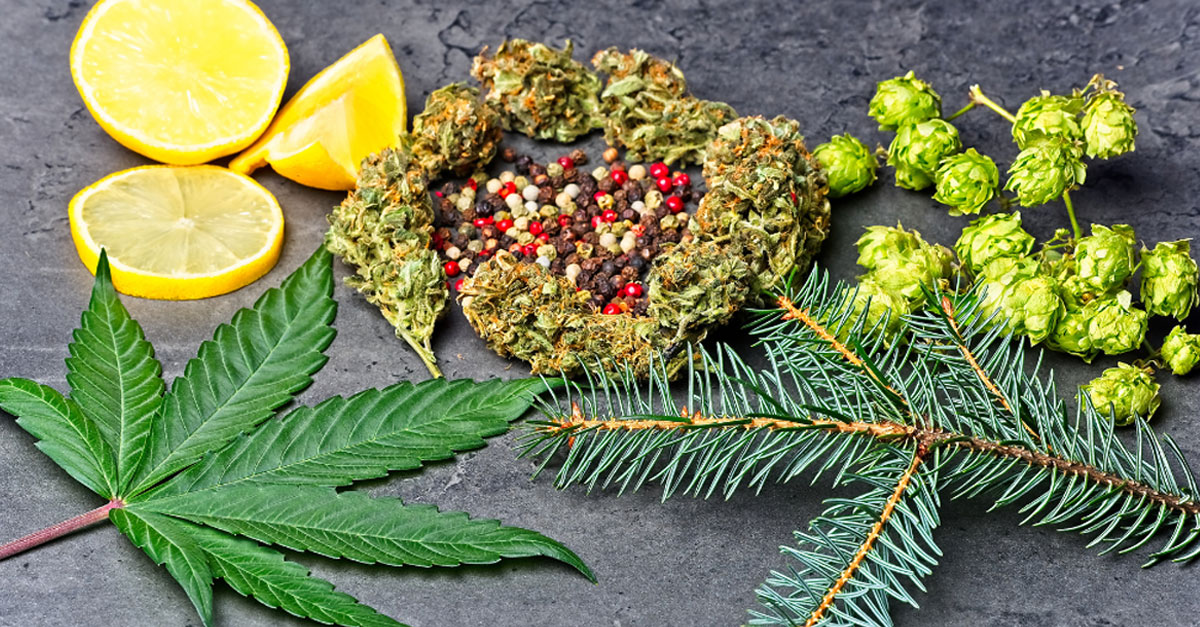What’s The Deal With Terpenes?

What’s The Deal With Terpenes?
With the ever-emerging amount of cannabinoids, we know that cannabis isn’t just THC and CBD. In truth, the cannabis plant contains more than 200 compounds! These include cannabinoids, flavonoids, and terpenes. Lately, there has been a spotlight on the therapeutic potential of cannabis terpenes. They have been found to play a significant role in the effects of cannabis, including the entourage effects and the difference in strains.
What Are Terpenes?
Terpenes are organic compounds that are found in many plants, including cannabis. They are responsible for the aroma and flavor of plants and play an essential role in their defense against predators and environmental stressors. Terpenes are also found in essential oils and are commonly used in aromatherapy and natural remedies.
In cannabis, terpenes are produced in the same glandular trichomes as cannabinoids and are present in the plant’s flowers, leaves, and stems. There are more than 100 terpenes that have been identified in cannabis, each with its unique properties and benefits.
What Roles Do Terpenes Play in Cannabis Effects?
Terpenes play an essential role in the effects of cannabis strains. More and more dispensaries are listing terpene profiles on their product labels. We are moving away from identifying strains as simply “sativa” or “indica” and getting specific with terpenes.
The most common terpenes found in cannabis (and typically the ones listed on a product) are myrcene, limonene, pinene, caryophyllene, and linalool. Each cannabis terpene has its unique characteristics that contribute to the plant’s overall effects. For example, while limonene has a citrusy aroma and is believed to have mood-enhancing properties, myrcene has an earthy aroma and is believed to have sedative effects. And while pinene has a piney aroma and is believed to have anti-inflammatory properties, linalool has a floral aroma and is believed to have calming effects.
In addition to their unique aromas and effects, cannabis terpenes also work in synergy with cannabinoids to enhance their impact. This phenomenon is known as the entourage effect, and it suggests that the combination of cannabinoids and terpenes produces more significant results than either compound alone. Let’s take a look at the five most common terpenes:
Myrcene
It is commonly believed that the more myrcene in a strain, the more indica it is. Myrcene is responsible for the earthy, musky aroma of cannabis. It is also found in other plants, such as mangoes, hops, and bay leaves. Myrcene is known to have sedative effects and is believed to enhance the psychoactive effects of THC. It is also thought to have anti-inflammatory properties, making it a possible pain treatment. In addition, Myrcene may be a potent antioxidant and has been shown to have neuroprotective effects.
Limonene
As its name implies, limonene gives cannabis its citrusy, lemony aroma. It is also found in lemons, oranges, and juniper plants. Limonene has been shown to have several potential health benefits, including anti-inflammatory and anticancer properties. It is also known to have anxiolytic effects. This means that limonene may help reduce anxiety and therefore improve mood. This terpene has also been shown to have antifungal and antibacterial properties, making it a potential treatment for skin conditions and infections.
Pinene
Pinene is a terpene found in an array of plant-based organisms, including cannabis, pine trees, rosemary, and basil. It has a distinct aroma resembling fresh pine needles that cannabis consumers often desire. In addition to its unique scent, multiple scientific studies have suggested pinene provides therapeutic properties with the potential to act as both an anti-inflammatory and bronchodilator while stimulating cognitive function and memory retention.
Caryophyllene
Caryophyllene is recognized for its distinct spicy and woody aroma, which bolsters the character of cannabis strains. This terpene is found in many different plants, like black pepper, cloves, and cinnamon. Research suggests that caryophyllene has anti-inflammatory and pain-relieving properties. It is also the only known terpene to activate CB2 receptors that regulate inflammation levels and act as a cannabinoid.
Linalool
Linalool is known for its floral, lavender-like aroma, which can add a calming element to cannabis strains. It is also found in lavender, mint, and coriander. Linalool has also been studied for its potential therapeutic properties, such as its ability to act as an anti-anxiety and sedative agent. Some research has suggested that linalool may also have analgesic and anti-epileptic effects. Like myrcene, linalool can give a cannabis strain more indicia-like effects.
In closing, we hope this week’s article has shed some light on terpenes and what they mean for cannabis. So next time you grab some high-quality flower from your local dispensary, check out the terpene profile label. It will make choosing the best strain for you a lot easier.
Latest GreenCore News
CBGA: The Mother of All Cannabinoids
CBGA: The Mother of All Cannabinoids CBGA, often called the "mother of all cannabinoids," is gaining significant attention. This foundational cannabinoid is showing promise in reducing seizures and treating conditions like insomnia and chronic pain. Recently, its...
Cannabis Concentrate Spotlight: Rick Simpson Oil
Cannabis Concentrate Spotlight: Rick Simpson Oil Rick Simpson Oil has become a cornerstone in the world of cannabis products. Renowned for its versatility, this concentrate offers a multitude of benefits for both medical patients and recreational users.In this blog,...
CBD 101: Properties, Production, and Potential
CBD 101: Properties, Production, and Potential CBD has rapidly evolved from a little-known compound to a household term. But while it has become a ubiquitous term, many remain unclear on what cannabidiol actually is. In this blog, Green Core Specialty Insurance...
Contact Us
Office Location
1600 Golf Road, Suite 1200
Rolling Meadows, IL 60008
Office Hours
M-F: 8am - 6pm
Phone
847-201-4600



